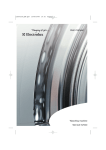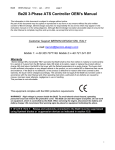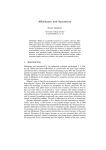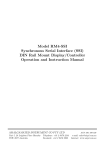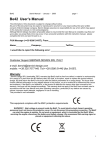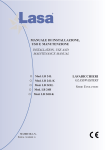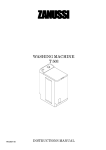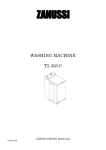Download Electrolux 2060 D Ventilation Hood User Manual
Transcript
LAVAMAT 42230 ELECTRONIC The washing machine that is friendly to the environment User's instructions Dear Customer, Please keep this User’s Instructions with your machine. If you sell or give your machine to someone else, don’t forget to include the User’s Instructions. It will inform the new user about how to operate it and about necessary precautions. Safety instructions . 1.2. Step by step description of operations ….. 3. ….. Advice and recommendations Information about protection of the environment 2 This manual is printed on paper that protects the environment. It is not enough to think about the environment, action is necessary. CONTENTS User's instructions .............................................................. 5 Important warnings ........................................................................................... 5 Protection of the environment ....................................................................... 8 Wasching machine description ....................................................................... 9 Detergent dispenser ............................................................................................. 9 Control panel ....................................................................................................... 10 Consumption and programme duration ................................................... 13 Washing guide ................................................................................................. 14 Products .............................................................................................................. 16 International symbols for care of textiles ................................................ 17 How to do your washing................................................................................ 18 Programme tables ........................................................................................... 25 Cleaning and maintenance ............................................................................ 27 Troubleshooting............................................................................................... 29 Installation and connection instructions ..................... 31 Safety instructions for the installation ..................................................... 31 Washing machine dimensions ..................................................................... 32 3 Contents Installing your washing machine ................................................................ 33 Position .............................................................................................................. 35 Leveling and moving the washing machine ............................................ 35 Electrical connection ....................................................................................... 36 Water connections ........................................................................................... 37 Technical characteristics ................................................................................ 39 Guarantee conditions and After Sales service .......................................... 39 4 USER'S INSTRUCTIONS Important warnings These warnings were written for your own safety and for the safety of others. Before using your washing machine for the first time Respect the “Installation and connection instructions” given below. Usage This washing machine was designed for use by adults. Make sure that children do not touch it or play with it. Unpack your washing machine immediately when you receive it, or ask someone else to unpack it for you. Check its general appearance. If you have any reserves, write them on the delivery form, and keep a copy of it. Your washing machine is designed for normal domestic use. Do not use it for commercial or industrial purposes or for anything other than the purposes for which it was designed. Do not modify or attempt to modify the characteristics of this washing machine. This would be dangerous for you. Always pull out the plug and turn off the water supply tap when you have finished using the washing machine. Only wash articles that will resist machine washing. Follow the instructions on the label attached to each article. Do not use your washing machine to wash articles with whalebones, material without hems or torn material. Remember to take out coins, safety pins, broaches, screws, etc. before putting clothes in the washing machine. This type of item can cause serious damage if it is left in the washing. Do not put articles in the washing machine if you have just cleaned them using a stain remover containing gasoline, alcohol, trichloroethylene, etc. If you use this type of stain remover, wait until the product has evaporated before putting your washing in the drum. 5 User's instructions Put all small items such as socks, belts, etc., together inside a small cloth bag or pillow case, so that they cannot get trapped between the drum and the tank. Leave the cover and the drum open when you are not using your washing machine, to air the tank and prevent the formation of mould and bad smells. Always unplug the washing machine before cleaning and servicing it. Use only detergents designed for the washing machine. Follow the recommendations made by the manufacturer of these products. If the washing machine is installed in a location subject to frost, completely drain the washing machine and unscrew the tap supply pipe and put it down on the floor. Elements forming part of the packaging (for example plastic films, pieces of polystyrene) can be dangerous for children. Keep these packaging elements out of reach of children. Make sure that pets cannot get into the drum of your washing machine. Never use the washing machine if the power supply cable, the control panel, the working surface or the base are damaged so that the inside of the washing machine is accessible. Safety devices Cover: your washing machine is equipped with a safety device preventing the washing machine cover from closing when the drum doors are open. It is impossible to start it until the doors are closed. An electromechanical safety device prevents you from opening the cover while the washing machine is operating, and for about 2 minutes after the end of the programme. Washing motor: a temperature safety device protects the motor against risks of mechanical overload, or overvoltage or undervoltage. Heating: heating will not start until the water quantity necessary for washing has been added into the tank. This safety device is effective mainly when the water supply is cut off or if you forget to open the water supply tap. 6 User's instructions The anti-foam system: water consumption is very low, due to the electronic spin cycle with an intermediate spin after the main wash and three rinse cycles for white and color programs. The spin cycle remains under the control of the foam detection system after the wash cycle has finished. If necessary, the spin cycle will stop until all foam is removed. The unbalanced weight protection system: this safety system keeps the washing machine stable during intermediate spins or the final spin and therefore detects any bad distribution of your washing (small load or tangled washing). It can then remedy this situation. The drum self positionning system: this electronic system ensures that the doors are in the upper position when the wash programme finishes. This system allows for easier loading and unloading of the laundry. If an unbalanced weight alters the functionning, turn the drum by hand. 7 User's instructions Protection of the environment All materials marked with the symbol can be recycled. Place them in a waste collection bin provided for this purpose (ask your local municipal services) so that they can be recovered and recycled. Plastics are identified as follows: >PE< for polyethylene, for example for the surrounding cover and envelopes containing the documentation; >PS< for expanded polystyrene, for example packing parts practically free of HCFC. Cardboard is made from recycled paper and therefore should be discarded in waste paper collection bins. We recommend that the following instructions should be followed to save water and energy, and therefore contribute to protecting the environment: - When possible, use full loads rather than partial loads in your washing machine (however do not overload the drum). - Only use programs with prewash for very dirty washing. - Adapt the amount of detergent to the water hardness, to the amount of your washing, and how dirty it is. If you scrap your old washing machine, make sure that you put everything that could be dangerous out of service; cut the power supply cable flush with the washing machine, and prevent the door latch from closing. Automatic adjustment of water consumption This automatic adjustment system adapts the water consumption as a function of the quantity and nature of the washing. If you have an operating problem, refer to the “TROUBLESHOOTING” section. If you need help after having made all these verifications, you should normally call the After Sales Service of the company which sold you the washing machine. If this is impossible (if you have moved, or if the shop in which you bought your washing machine has closed, etc.), please call the Consumer Advice Service which will then inform you of the address of an After Sales Service. 8 User's instructions Washing machine description Front view Control panel Lid Handle for opening the lid Filter access door Adjustable stands Lever for lifting the washing machine onto rollers Detergent dispenser Powder detergent for programs with prewash (compartment 1). Powder or liquid detergent for the main wash (compartment 2). 4 Liquid additives (softener, crease remover, starch, etc.) (compartment 3). 4 Softener overflow. 9 User's instructions Control panel Spin pushbutton/RINSE HOLD Additional programme pusbuttons Delayed start pushbutton Start/Pause pushbutton Programmes procedure Programme selector Door control lamp Programme selector It is used to select the most suitable programme to the type and soiling of your laundry. It can be turned to the right or to the left. OFF " " This position of the programme selector switchs off the appliance. Moreover, thanks to this option, you can cancel a programme which has already been selected. Another programme can then be selected. COTTONS/LINEN " " Main wash for coloured or white laundry from 30° C to 95° C. SYNTHETICS " " Main wash for lightly soiled fabrics from 40° C to 60° C. 10 User's instructions EASY IRONING position " " Wash at 40° C for mixed clothes. Thanks to this programme, clothes require only light ironing or even no ironing at all. DELICATES " " Main wash for delicates fabrics at 30° C or 40° C. WOOL " " / HANDWASH " " Main wash (cold " " or 30° C) for machine washable woollen garments and also for all other garments carrying the "hand washable" symbol. RINSE DELICATE " " Separate rinse which can, for instance, be used to rinse and spin handwash garments. The appliance performs 3 rinses cycles and a short spin. DRAIN " " Separate drain of the water after a rinse hold (without spinning). The effect of the rinse hold function is that the washing is left to soak in the last rinse water, without spinning. SPINNING " " Drain of the water after a rinse hold and spin or separate spin for handwashed cotton garments. ENERGY SAVING "E" By washing normally soiled white clothes at around 60°C, this programme saves water and energy. Furthermore, it increases the wash duration and it can not be combined with the QUICK pushbutton " ". 11 User's instructions Additional programme pushbuttons Additional programme pushbuttons enable to adapt the washing programme to the laundry soil level. It is not necessary to use these options so as to wash normally soiled garments. The use of the different options depends on the chosen programme. When these buttons are pressed, the corresponding lights illuminate. When pressed again, the corresponding lights extinguish. When an additional function is not compatible with the selected programme, the corresponding lights does not illuminate. PREWASH " " Prewash at 30° C before the main wash which starts automatically. The prewash ends by a short spin as far as the white/coloureds, synthetics programmes are concerned and by a drain of the water for the delicate garments. It is not possible to select the prewash option with the wool and handwash programmes. QUICK " " Shortened wash programme for lightly soiled washing. This function can not be used on the wool and handwash programmes. Delayed start pushbutton " " This option delays start of the programme. Select the number of hours after which you want the programme to begin by pressing on the pushbutton repeatly. 12 User's instructions Consumption and programme duration Timer / Temperature Washing Water Energy Duration quantity consumption consumption in minutes in kg in liters in kWh WHITE / COLOUREDS 95 5,0 63 2,10 140 - 150 ENERGY SAVING 60 1) 5,0 49 0,95 140 - 150 WHITE / COLOUREDS 40 5,0 58 0,65 115 - 125 SYNTHETICS 60 2,5 57 1,10 90 - 100 EASY IRONING 40 1,0 65 0,40 85 - 95 DELICATES 30 2,5 52 0,60 65 - 75 WOOL 40 1,0 53 0,35 50 - 60 1) Programme setting for testing in accordance with standard EN 60 456. Values given in the above table are provided as a guide and may vary depending on the water supply temperature and pressure, and your electricity power supply mains voltage. 13 User's instructions Before the first wash Before using your washing machine for the first time, we recommend you to do a preliminary wash with the machine empty, as a precaution to clean the drum, tank and the product box. 1. Pour a dose of detergent in the “washing” distributor. 2. Select the WHITE / COLOUREDS 95°C program. 3. Press the START/PAUSE button " ". Preparing a Wash Load Sorting and preparing a wash load 14 • Sort washing according to the care symbol and type (see "Washing types and care symbols"). • Empty all pockets. • Remove metal objects (paper clips, safety pins etc.). • In order to prevent bunching up of washing and damage to washing, close zippers, button up duvet covers and pillow cases, and tie up loose straps such as from aprons. • Turn articles with double layered textiles inside out (sleeping bags, anoraks etc.). • Coloured, knitted fabrics, as well as wool and fabrics with appliqués should be turned inside out. • Place small and delicate items (e.g. socks, tights and stockings, bras etc.) in a washing net, or pillow case. • Handle curtains with care. Metal rollers or burred, plastic rollers must be removed or tied into a net or bag. We cannot accept liability for damage. • Do not wash coloured and white washing together. This could discolour white washing or turn it grey. • New, coloured washing often contains excessive dye. Wash these separately the first time. • Mix small and large items of washing. This improves washing efficiency and the washing is more evenly distributed during the spinning cycle. • Shake out washing before placing into the washing machine. • Do not place folded washing into the drum. • Observe tips such as "wash separately“ and "wash separately several times". User's instructions Types of Washing and Care Symbols Care symbols help you to choose the correct wash programme. Washing should be sorted by type, and according to their care symbols. The temperature indicated on the care symbol is the maximum wash temperature. Washing that can be boiled Cotton and linen textiles marked with this maintenance symbol are not delicate. They will resist high temperatures and mechanical forces. The WHITE program is appropriated for this washing type. Coloured washing Cotton and linen textiles marked with this maintenance symbol are not delicate. They will resist high mechanical forces. The COLOUREDS program is appropriated for this type of washing. Easy to maintain washing Textiles such as finished cotton, blended cotton based materials and synthetic materials marked with this symbol require more gentle mechanical treatment. The TEXTILE BLENDS program is appropriated for this type of washing. Delicate washing Textiles such as layered, micro-fiber, synthetic textiles and net curtains marked with this maintenance symbol require particularly gentle treatment. The DELICATE program is appropriated for this type of washing. Wool and particularly delicate washing Textiles such as woolens, wool blends or silk marked with this label are particularly sensitive to mechanical forces. The WOOLENS program is appropriated for this type of textile. Woolen clothes marked with the (wool) label are only machine washable if the comment “non-fluffing” or “fluff resistant”, and “machine washable” is added. (hand washable) label or Textiles marked with the cannot be washed in the washing machine! (do not wash) label Follow the “wash separately” or “wash separately several times” maintenance instructions. 15 User's instructions Products Choice of detergent Manufacturers always mark maximum detergent quantities to be used on their detergent packages, depending on the amount of washing. Comply with doses and instructions specified on packages. Proportioning Water hardness in mmol/l Hardness range The quantity of detergent to be used (millimoles per liter) depends on the amount of washing to up to 1,3 be washed, the hardness of the water I - soft and how dirty your washing is. II - medium 1,3 - 2,5 Reduce doses slightly if the water is 2,5 - 3,8 soft. Increase doses slightly if the III - hard water is hard, or if the washing is very IV - very hard more than 3,8 dirty or stained. You can determine the degree of hardness of your water by asking the water distribution utility in your region or any other competent authority. Note: Only use low foam detergents sold in the shops specially for use in washing machines. Use neutral products for washing woolens. If you use liquid detergents, put the proportioning ball directly in the drum and choose a program without pre-wash. If you dry your washing in a drier, do not forget to take out the proportioning ball. You can also add liquid detergent for your washing into the drum directly, provided that you do not do a pre-wash and you start your washing machine immediately. Liquid detergents are suitable for low temperatures (namely 30°C and 40°C). It is recommended that a powder detergent should be used for higher temperatures from 60°C to 90°C. Softener With this distributor, you can automatically add a liquid softener to your last rinse water. Respect the proportions shown on the flask, depending on the nature of the softener used (normal or concentrated). Do not exceed the maximum softener quantity (80 ml) specified for the product box. An overflow orifice under the softener display window will inform you if you add too much. It is recommended that you should add a softener product while washing to facilitate drying and make your washing softer. It can also help to eliminate static electricity. 16 Max. wash Max. wash Max. wash Max. wash temperature 95°C temperature 60°C Temperature 40°C Temperature 30°C Delicate wash Bleach in cold water BLEACHING Hand wash Do not wash at all Do not bleach IRONING Hot iron max. 200°C Warm iron max. 150°C Lukewarm iron max. 110°C Do not iron DRY CLEANING Dry cleaning in all solvents Dry cleaning in perchlorethylene petrol, pure alcohol, R111 & R113 Dry cleaning in petrol, pure alcohol, and R 113. Do not dry clean International symbols for care of textiles Strong wash High temperature. Low temperatrue Flat On the line On clothes hanger Tumble dry Do not tumble dry 17 User's instructions DRYING User's instructions Running a washing cycle Brief instructions A washing cycle consists of the following steps: 1. Open the lid and the drum ; load the washing. 2. Add detergent/conditioner. 3. Close the drum and shut the lid. 4. Set the appropriate washing programme: - Set the programme and temperature using the programme selector. - Set programme options as required. 5. Change the spin speed or select the RINSE HOLD function " " as necessary. 6. Start the washing programme by pressing the START/PAUSE pushbutton " ". Important! If the washing cycle ended with a rinse hold, select the DRAIN " " or the SPIN " " programme before opening the lid. 7. Open the lid and the drum ; remove the washing. The lid can be opened after the DOOR light " " " goes off and the END light " has come on. 8. To switch off the washing machine: turn the programme selector to the OFF position " ". 18 User's instructions Opening and closing the lid . . To open: lift the lid. To close: push the lid firmly shut. When the machine is switched on, the DOOR light " " and the START/PAUSE light " " indicate whether the door can be opened. DOOR light " 1) " START/PAUSE light " " Can the lid be opened? flashes flashes yes, after about 2 minutes. lit lit no1) is off flashes yes The lid is locked due to high temperature. If the END light " " flashes 4 times and an acoustic signal is emitted 4 times*, it means there was an attempt to start a wash programme without closing the door properly. If this happens, push the lid firmly and start the wash programme again. *Depending on model, some acoustic signals may appear. Loading the washing See "Programme tables" for maximum loads. For inforamtion about the correct preparation of the washing see "Sorting and preparing washing". 1. Sort and prepare the washing according to type. 2. Lift the lid. 3. Open the drum by pressing the release button. 4. Load the washing. 5. Shut the drum (the button must be released) and then close the lid. 19 User's instructions Adding detergent/conditioners For instructions regarding detergent and conditioners, see the "Products" section. Liquid additives compartment (softener, crease remover, starch) Warning! Do not exceed the MAX level. Prewash/Soak compartment for additional programmes (PREWASH/SOAK*) Main wash compartment If you use a water softener and need the compartment for the prewash/soaking agent, add the water softener to the compartment with the main wash detergent. If using liquid detergents/tablets: Add liquid detergent or tablets using the dosage container provided by the detergent manufacturer. Follow the instructions on the detergent packaging. * Depending on the model. 20 User's instructions Setting the washing programme For the appropriate programme, temperature and possible programme options suitable for any type of washing, see "Programme tables". 1. Select the desired wash programme and temperature with the programme selector. 2. If required, select the appropriate programme option(s): the indicator of the selected programme option illuminates. - To change the selection, press another button. - To cancel a selection, press the button again. Selecting a delayed start Before starting the programme, if you want to delay it, press the DELAYED START pushbutton " " until the desired delayed start is displayed. Changing Spin speed / selecting a rinse hold To change the spin speed for the final rinse or to select a rinse hold: Press the spin speed/rinse hold pushbutton until the indicator light for the desired speed (or rinse hold) illuminates. If a rinse hold position " " is selected, the washing is left to soak in the last rinse water, without spinning. If the spin speed is not changed, the final spin is automatically adjusted to suit the washing programme: - COTTONS/LINEN - ENERGY SAVING - SYNTHETICS/EASY IRONING - DELICATES - WOOL 1200 1200 900 900 900 rpm rpm rpm rpm rpm The speed of intermediate spins depends on the selected programme and cannot be changed. 21 User's instructions Additional rinse cycles (RINSE+) " " The washing machine is set for very economical water consumption. However, people who suffer from allergies to detergents can rinse their laundry with more water. If the RINSE+ option " " is selected, two extra rinses are added to the COTTONS/LINEN, SYNTHETICS, EASY IRON, and DELICATES programmes. When delivered, the machine is not set for additional rinses. To set the additional rinse cycles: 1. Turn the programme selector to a COTTONS/LINEN, SYNTHETICS, EASY IRON, or DELICATES programme (any temperature). 2. Press and hold the PREWASH " " and the DELAYED START " " pushbuttons at the same time for at least 2 seconds. On the programme progress display the RINSE " " and RINSE+ " " lights come on. The additional rinse cycles are set. It remains set until cancelled again. The additional rinse cycles raise water consumption and extend programme times. To cancel the additional rinse cycles 1. Turn the programme selector to a COTTONS/LINEN, SYNTHETICS, EASY IRON, or DELICATES programme again. 2. Press and hold the PREWASH " " and the DELAYED START " " pushbuttons at the same time for at least 2 seconds. The RINSE+ light " " goes off on the programme progress display. The additional rinse cycles are cancelled. 22 User's instructions Starting the wash programme 1. Check that the water tap is open. 2. To start the wash programme, press the START/PAUSE pushbutton " ". The wash programme starts. If the END light " " flashes 4 times and an acoustic signal is emitted 4 times* when the START/PAUSE pushbutton " " is pressed, the lid is not properly closed. In this case, push the lid in firmly, and press the START/ PAUSE pushbutton " " again. * Depending on the model, some acoustic signals may appear. Programme progress Programme progress display Prior to the start, the chosen programme stepd are displayed by the programme progress display. During the wash programme, the current programme step is displayed. Changing the washing programme Changing or cancelling the programme 1. Press the START/PAUSE pushbutton " ". 2. Turn the programme selector to the OFF position " ". The washing programme is cancelled. 3. Set another washing programme, if required. Otherwise, turn the programme selector to the DRAIN " " or SPIN " " programmes and press the START/PAUSE pushbutton " ". The washing programme can be temporarily interrupted at any time by pressing the START/PAUSE pushbutton " ". It is then re-started by pressing the pushbutton again. A washing programme can only be changed after the programme selector has been turned to the OFF position " ". Selecting a programme option The programme option QUICK " " can still be selected after the programme has started. 1. Press the START/PAUSE pushbutton " ". 2. Press the QUICK pushbutton " ". 3. Press the START/PAUSE pushbutton " ". The washing programme goes on. 23 User's instructions Changing the spin speed The spin speed can still be changed or the RINSE HOLD position " " set, while the programme is running. 1. Press the START/PAUSE pushbutton " ". 2. Change the spin speed with the Spin Speed/RINSE HOLD pushbutton. 3. Press the START/PAUSE pushbutton " " again. The washing programme continues. Washing cycle complete/removing the washing Once a washing programme cycle ended, the END light " " illuminates on the Programme Progress Display. If RINSE HOLD position " " was selected, the indicator lights beside the DOOR " " and END " " lights illuminate. 1. After a Rinse Hold, the water must first be drained: – Either turn the programme selector to the OFF position " ", then turn it to the DRAIN programme " " and press the START/PAUSE pushbutton " " (the water is drained without spinning), or – turn the programme selector to the OFF position " ", then turn it to the SPIN programme and press the START/PAUSE pusbutton " " (the water is drained and the washing given a spin. The spin speed can also be changed during the spin cycle). When this stage of the programme is completed, the END light " " illuminates. 2. Open the door. The door can be opened after the DOOR light " " goes off and the END light " " has come on. 3. Remove the washing. 4. Turn the programme selector to the OFF position " ". 5. Close the water tap. 6. Leave the drum and the lid open to air the washing machine. Important! If the washing machine is not to be used for a long period, close the water tap and disconnect the washing machine from the electricity mains. 24 User's instructions Programme tables Washing This table does not include all possibilities, simply the best and most usual adjustments in practice. Washing type / Care label Max. washing quantity COTTONS/LINEN 95 Washing to be boiled Other possible options Timer Temperature or 5,0 kg ENERGY SAVING 60 Cotton / Coloureds1) Coloureds 5,0 kg COTTONS/LINEN 30 - 60 2,5 kg SYNTHETICS 40 - 60 1,0 kg EASY IRONING 40 Easy care washing or Delicates 2,5 kg Wool / Handwash 1,0 kg 1) or DELICATES 30 - 40 or WOOL / HANDWASH Cold " " - 30 Programme setting for testing in accordance with standard EN 60 456. 25 User's instructions Separate rinse Washing type Max. washing quantity (dry weight) Washing to be boiled Coloureds 5,0 kg Easy care washing 2,5 kg Delicate washing Wool 2,5 kg 1,0 kg Timer Separate spin Washing type 26 Max. washing quantity (dry weight) Washing to be boiled Coloureds 5,0 kg Easy care washing 2,5 kg Delicate washing Wool 2,5 kg 1,0 kg Timer User's instructions Cleaning and maintenance Always unplug your washing machine before cleaning. Removing scale from your washing machine . It is usually not necessary to remove scale from the washing machine if the correct amounts of detergent were added. If you need to remove scale, use a special non-corrosive product specially designed for washing machines, that you can buy in the shop. Respect the dose and frequency of scale removal shown on the packaging. After each washing cycle . We recommend that you leave the cover and drum open after each wash, to air the tank and prevent the formation of mould and bad smells. Clean inside the cover and around the tank inlet using a sponge soaked in water (do not use a scouring pad). The cladding Clean the washing machine cladding using lukewarm water and a mild detergent. Rinse and dry carefully. Warning: never use alcohol, solvents or similar products, abrasives or a sponge with a scouring pad. The control panel Clean the control panel with lukewarm water and a moist sponge. The detergent dispensers fig.1 fig.2 fig.3 fig.4 fig.5 Removing the detergent dispenser Press on the clips on each side of the product box and pull it upwards (fig. 1 and fig. 2). You can thus clean it with running water using a brush or a twisted cloth (fig. 3). Check that the siphons at the back of the product box are not blocked (fig. 4). Replacing the box Put the product box back into position in the slots until it clicks into position (fig. 5). 27 User's instructions The drain filter Clean the filter at the bottom of the washing machine regularly. If your washing fluffs a lot, clean the filter after every wash. Lower the drain pipe into a large receptacle placed on the floor to drain any water remaining in your washing machine and then: . to drain all remaining water: a. Open the chute (fig. 1) b. Place a shallow receptacle with a straight edge under the chute. To finish draining, turn the drain filter plug until it is vertical to allow all remaining water to run out (fig. 2). . to clean the filter: a. Turn the filter in the anti-clockwise direction and take it out (fig. 3). b. Clean it carefully with running water. c. Put the filter back in position and screw it in the clockwise direction. d. Close the chute again. Fig.1 Fig.2 Fig.3 Precautions against frost If your appliance is exposed at a temperature lower than 0° C, take the following precautions: - Switch off the water inlet tap and the water inlet pipe. - Place the end of this pipe and this one of the drain pipe in a basin on the ground. - Select the drain programme " ". - Switch off the appliance by placing the selector programme on the OFF position " ". - Unplug the appliance. - Rescrew the water inlet pipe and replace the drain pipe. In this way, the water remained in the pipes is drained. So frost can not damage your appliance. For the future uses of your appliance, make sure that the temperature of the room where is located the machine is upper than 0° C. 28 User's instructions Troubleshooting The manufacturing process of your appliance has been subject to many checks. However, if you notice an operating fault, refer to the table below before calling the after-sales service. Whilst the appliance is operating, some error codes may appear. After having removed the possible causes of the fault, press the START/ PAUSE button " " to restart the interrupted cycle. If the error code reappears or if the fault has not disappeared, contact the after-sales service of your retail outlet. Symptoms Solutions The machine does not start. Check that: - the fuses are in good condition, - the appliance is correctly connected, - the lid of the appliance and the drum flaps are properly closed, - the Start/Pause button " " has been pressed, - there is not a power failure, - the water tap is fully open, - the water inlet filter is not blocked. The machine does not fill. Check that: - t h e wa t e r i n l e t t a p i s o p e n a n d t h a t there is sufficient pressure, - there is a water cut. The machine does not spin and/or does not drain. Check that: - the drain hose is not blocked or kinked, - the drain pump filter is not blocked, - the laundry load is correctly balanced in the drum, - the drain programme " " or the rinse hold option " " have been selected. The END light flashes 4 times and an acoustic signal is emitted 4 times*. - The lid is not closed properly. The END light flashes once and an acoustic signal is emitted*. Check that: - the water tap is not closed or blocked, - the filter in the socket of the inlet hose is not blocked. 29 User's instructions Symptoms The machine leaks or overflows. Solutions Check that: - there is too much detergent, - the detergent is suitable for machine washing, - the end of the drain hose is correctly secured, - the drain filter is properly replaced after cleaning, - the water inlet hose is not leaking. The washing results are not satis- Check that: - the detergent is suitable for machine washing, factory. - the machine is not overloaded, - the wash programme is suitable. The machine vibrates or is very noisy. Check that: - the transit bolts have been removed (see p. 34), - the appliance is level and installed correctly, - the appliance is not too close to a wall or other furniture, - the laundry is correctly distributed in the drum, - the appliance is not overloaded. The lid does not open. - The appliance is perhaps in the heating phase. - The lid is still locked. The wash cycle is much too long. Check that: - the water pressure is suficient, - the water inlet filter is not blocked, - there is not a water cut. The machine stops during a wash cycle. Check that: - the water pressure is sufficient, - the water inlet filter is not blocked, - the fuses are in good condition and have not blown, - the appliance is not finishing its wash programme by a rinse hold. The laundry is not spun sufficiently or water remains in the drum. Check that: - the drain hose is not kinked, - the height of the end of the drain hose is not higher than one metre, - the drain pump filter is not blocked. The END light flashes twice and an acoustic signal is emitted twice*. Softener flows out of the overflow hole. Check that: - you have used the correct amount, - the siphons on the rear of the detergent dispenser are not blocked. * Depending on the model, some acoustic signals may appear. 30 INSTALLATION AND CONNECTION INSTRUCTIONS Safety instructions for the installation If the electrical installation in your house needs to be modified so that you can plug your washing machine in, have the work done by a qualified electrician. Please read the instructions in the “Electrical connection” chapter carefully before plugging in your washing machine. Ask a qualified plumber to make the water connections for your washing machine. After you have put your washing machine into place, make sure that the power supply cable is not trapped under it. This washing machine is heavy. Take care when you move it. All packing devices must be removed from the washing machine before you use it. Severe damage may occur to the washing machine or adjacent furniture if you forget to remove any of the transport protection packing. Always unplug the washing machine before removing packing. All repairs to the washing machine must be made by qualified personnel. 31 Installation and connection instructions Washing machine dimensions Front and side views Back view 32 Installation and connection instructions Installing your washing machine Removing transport packing Warning! All parts used to protect internal components of the washing machine during transport must be removed before you use the washing machine for the first time. Keep these parts and their attachments in case you need to transport it again. 1.Remove the outer packaging from the washing machine. Tilt it backwards, rotate it by a quarter of a turn on one of its back corners to take it off the transport base. It will naturally be separated from the washing machine. 2.Open your washing machine cover and take out the packing that holds the drum in place and the plastic wedge. Close the cover again. 3.Use a spanner to unscrew and remove the two spacers (A) at the back of the washing machine. A +"#3 4.Now put the closers (B) provided in the pack attached to the washing machine into position to close the openings that became visible, and do not forget to fold back the plug into the middle. B +3# 33 Installation and connection instructions 5. Make sure that you have removed all these packing parts from the washing machine, and keep them in a safe place in case you need them for transport again (for example if you move). 6. If you want to keep your washing machine in line with adjacent furniture, you can cut the pipe support strip at the back of your washing machine. This will save about 2 to 3 cm in depth. Put the two side closers into position. 34 Installation and connection instructions Position In order to install your washing machine, you will need: An electricity power supply (see electrical connection). A water inlet with a 20 x 27 mm connection. A water drain with a minimum height of 70 cm. A ventilated room. Put your washing machine on a hard and flat floor. Make sure that your washing machine does not touch the wall or any other elements in the kitchen. Warning: when your machine is installed on a floor with a carpet, make sure that the carpet does not block any of the openings near the bottom of the machine, since they are necessary for ventilation. The tap, drainage installation and the power outlet must be close to the machine pipes and the power supply cable. Do not install the washing machine in a room subject to frost. Leveling and moving the washing machine Level the washing machine by screwing the leveling screws in or out. Precise leveling will prevent vibrations, noise and movements of the machine during operation. After leveling, fix the leveling screws in position by tightening the rings manually or using a screwdriver. When you want to move your washing machine, lift it on its rollers by pulling the lever at the bottom of the washing machine from the right towards the left. Put the lever back into its initial position once you have put the machine where you want it. 35 Installation and connection instructions Electrical connection Information about the mains power supply, the nature of the power and the fuses to be used are given on the washing machine name plate at the back of the washing machine. If the washing machine is directly connected to the electrical installation (fixed connection), insert a two-pole switch with a contact opening distance of not less than 3 mm. This washing machine can only be connected to 220-230 V single phase power supply. Check that the subscriber’s meter and fuses are capable of carrying the current required by the washing machine, allowing for other electrical equipment connected at the same time. Rating of line fuses (one for each phase): 10 A in 220-230 V single phase. Important: The installation shall comply with with the rules in force. Use a power outlet with an earthing pin, which shall be connected according to the rules in force. If the mains power supply cable has to be replaced, have the work done by the After Sales Service to make sure that it is done safely. Make sure that the earthing connector is conform with the rules in force. We cannot be held responsible if accidents or incidents are caused by a non-existent or defective earth. 36 Installation and connection instructions Water connections The washing machine is provided with safety equipment that prevents dirty water from flowing backwards into the drinking water supply pipes, in accordance with national water company specifications. Therefore there is no need to use any other additional protection in the installation. Warning! Washing machines designed to be connected to a cold water pipe must not be supplied with hot water! Allowable water pressure The water pressure shall be not less than 0,5 bar (= 0,05 MPa) and not more than 8 bar ( = 0,8 MPa). Install a pressure reducer if the pressure exceeds 8 bar. If the pressure is below 0,5 bar, unscrew the supply pipe on the magnetic inlet valve on the washing machine, and remove the flow regulator (to do this, you will need to remove the filter using pliers, and then rubber washer under it). Then put the filter back into position. This work can only be done by a qualified installer. Water supply A 1.5 m long supply pipe is provided with the washing machine. If you need to use a longer supply pipe, only use a complete set of pipes fitted with installed screw-on end pieces, supplied by our After Sales Service. Warning! Never use odd pieces of pipe as extensions! Sealing rings are supplied either inside the plastic nuts, or with the accessories supplied with the washing machine. Do not use other sealing rings! 37 Installation and connection instructions Connect the water inlet hose to a cold water tap with a 3/4" gas threaded orifice, after having inserted the rugger sealing washer into the hose collar. If the water connection is made onto new pipes or onto pipes which have not been used for a long time, it is advisable to run off a certain amount of water before connecting the machine. You can rotate the other end of the water inlet pipe at the machine end in any direction. Unscrew the tightening ring slightly, turn the end of the pipe as you wish and tighten the ring again firmly. Water drainage It is preferable to connect the drain pipe to a siphon. However, you can put it directly in a sink or a basin, or even into a bath. Only use original pipes as extensions (placed on the floor over a length of not more than 3 m and at a height of not more than 1 m). . . Water drained into a siphon The end piece fitted on the end of the pipe may be connected to any type of standard siphon. Use a clamping collar to keep the end piece in position on the siphon. Water drained into a sink When the drain pipe is placed in a sink or a wash basin, use the elbow supplied with the washing machine to prevent it from slipping. This pipe could be forced out of the sink under the pressure of the water being drained. Small sinks should be avoided ! You can avoid this problem by fixing the elbow to the water tap or to the wall using the orifice provided. 146 4281 00 38 Installation and connection instructions Technical characteristics Dimensions height with panel height without panel width depth Voltage / frequency Total power Heating power Fuse rating Water pressure Max spin speed cotton synth./wool delicates 895 850 397 600 mm mm mm mm 220-230 V / 50 Hz 2300 W 1950 W 10 A minimum maximum 0,05 MPa (0,5 bar) 0,8 MPa (8 bar) from rinse hold to 1200 rpm from rinse hold to 900 rpm from rinse hold to 900 rpm This washing machine complies with directive CEE 89-336 concerning the limitation of radioelectric disturbances and directive CEE 73-23 dealing with electrical safety. Guarantee conditions and After Sales service Please contact our AEG agents' of the country directly. 39 AEG Hausgeräte GmbH Postfach 1036 D-90327 Nürnberg http: //www.aeg.hausgeraete.de Copyright by AEG 146 4281 00 - 10/02 From the Electrolux Group. The world's No.1 choice. The Electrolux group is the world's largest producer of powered appliances for kitchen, cleaning and outdoor use. More than 55 million Electrolux Group products (such as refrigerators, cookers, washing machines, vacuum cleaners, chain saws and lawn mowers) are sold each year to a value of approx. USD 14 billion in more than 150 coutries around the world.








































